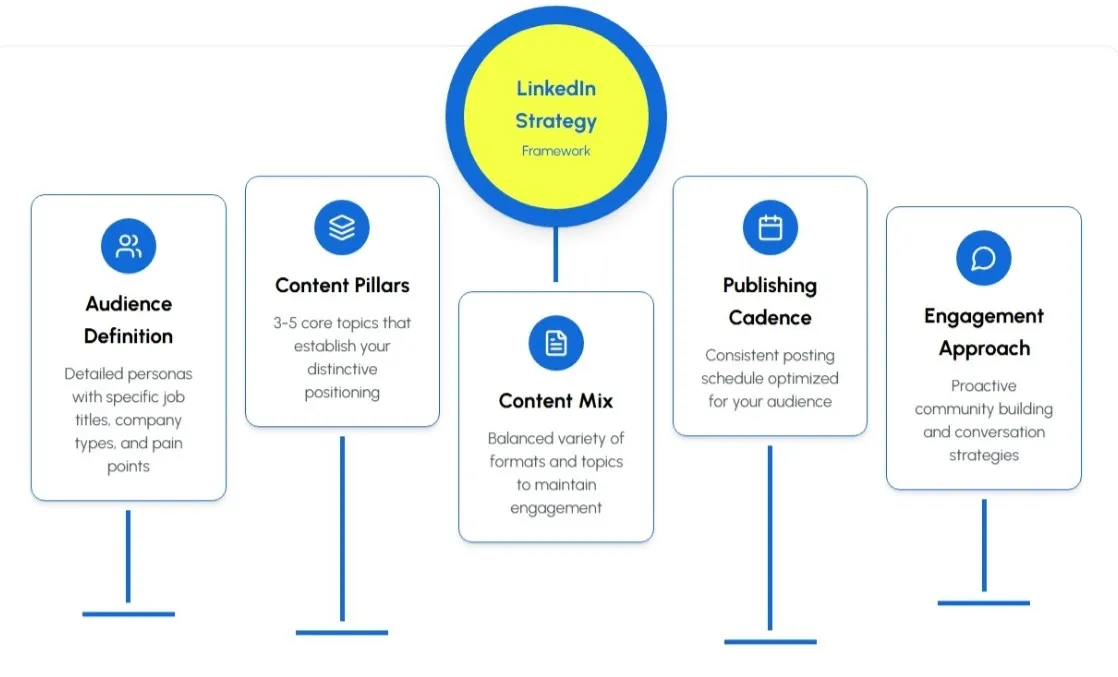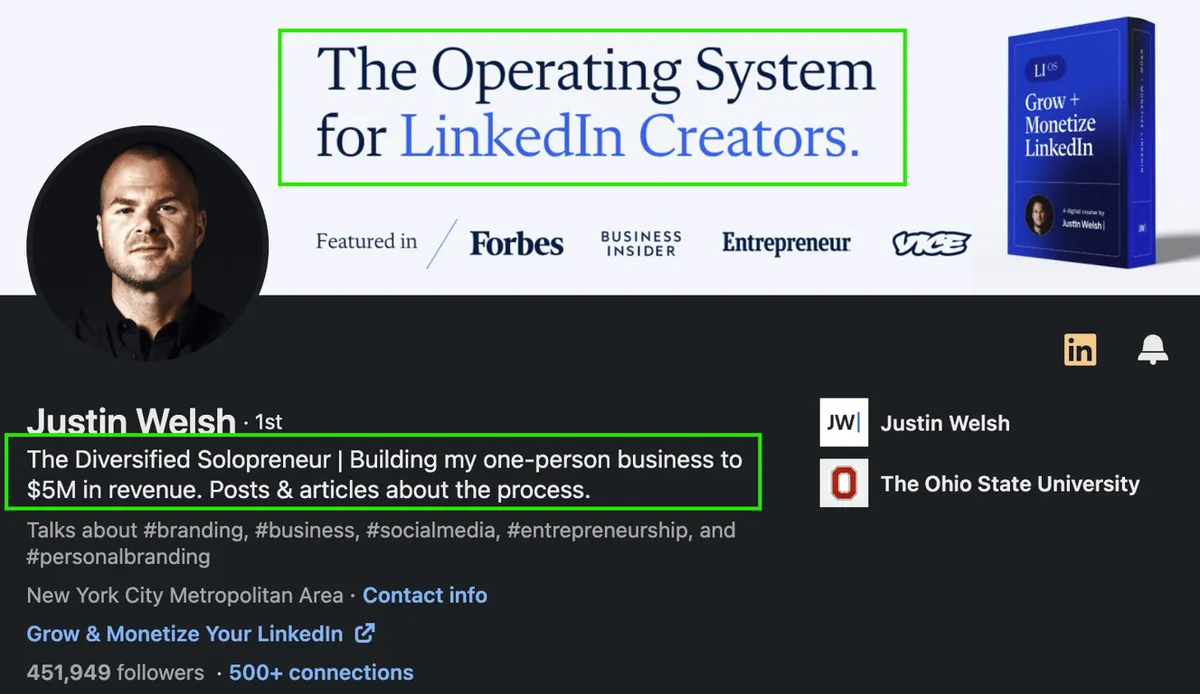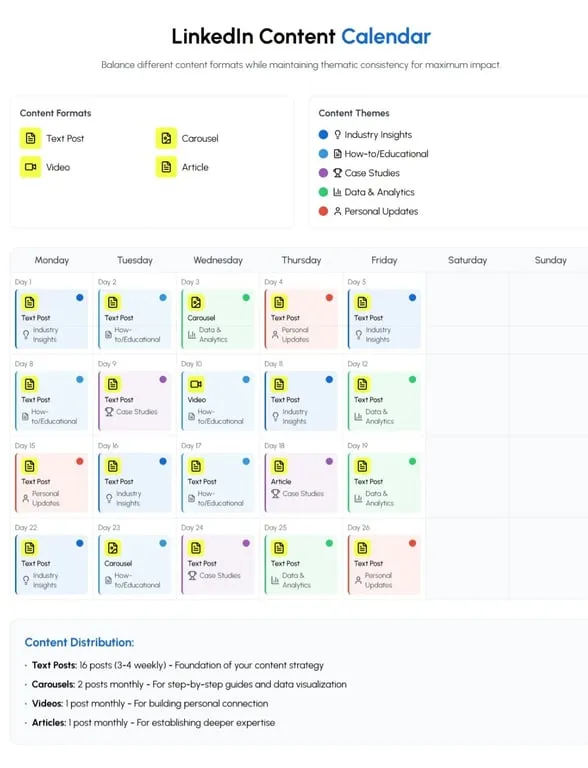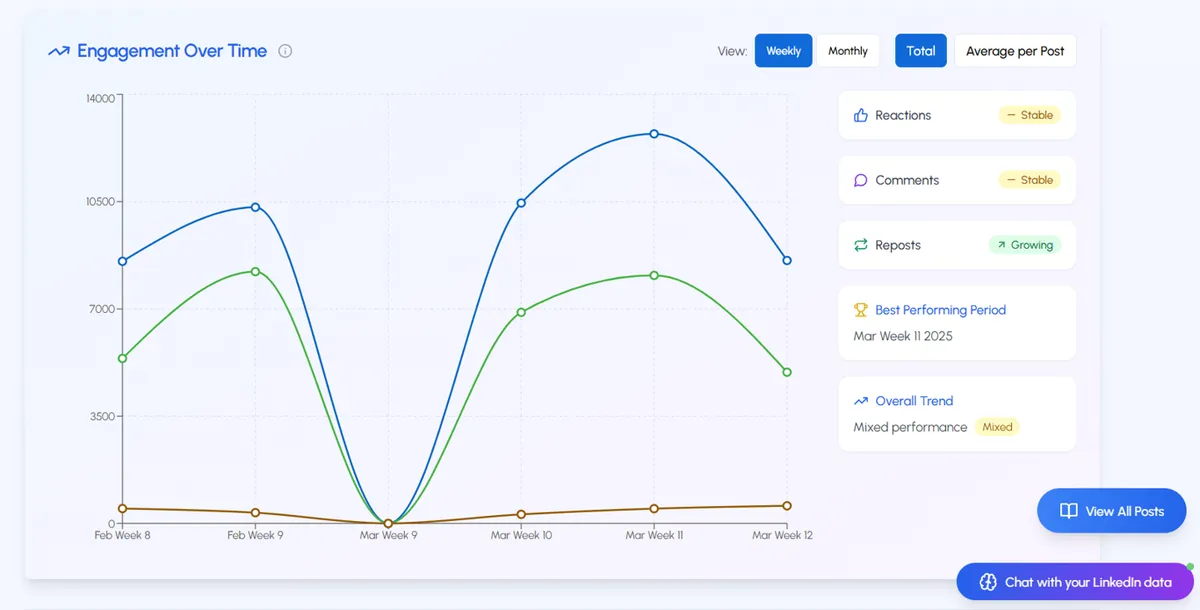Your LinkedIn profile is more than a digital resume-it's the cornerstone of your professional identity. For agency owners and founders, a deliberate personal brand on LinkedIn creates a powerful competitive advantage that traditional business development simply can't match.
Consider this: 80% of B2B leads from social media come from LinkedIn, and decision-makers consume an average of 10 pieces of content before making purchasing decisions. More importantly, content on LinkedIn reaches 20x more people through personal profiles than company pages.
These statistics reveal a critical truth-personal brands now outperform company brands in terms of reach, engagement, and conversion. This comprehensive guide will help you develop a LinkedIn personal brand strategy that attracts ideal clients, establishes your authority, and creates valuable business relationships.
The Strategic Foundation of LinkedIn Personal Branding

Most professionals approach LinkedIn branding tactically-updating their headline or posting occasionally without a cohesive strategy behind these actions. This fragmented approach yields fragmented results. Instead, start by establishing your brand foundation.
Defining Your Professional Identity
Your LinkedIn brand begins with clarity about who you are professionally and the unique value you provide. This isn't merely about listing skills or experiences, but articulating what makes your approach distinct.
Start by defining your professional identity through several key questions:
What specific problems do you solve better than anyone else? Rather than claiming broad expertise ("digital marketing consultant"), focus on the specific challenges where you deliver exceptional results ("helping SaaS companies reduce customer acquisition costs by optimizing their content funnels").
Who specifically benefits from your expertise? The more precisely you define your audience, the more compelling your brand becomes to that exact group. "SaaS founders struggling with high customer acquisition costs" is far more powerful than "businesses looking to grow."
What unique methodology or approach sets you apart? Your process often differentiates you more than your services themselves. A software development agency might stand out not because they build apps (many do), but because they use a unique "client immersion framework" that yields better results.
As one marketing expert notes on Reddit, "Think about what sets you apart from the crowd. What unique skills, experiences, or perspectives do you bring to the table?" This differentiation becomes the cornerstone of your LinkedIn personal brand.
Understanding Your Brand Position
Effective personal branding requires positioning yourself within your professional landscape. Consider these dimensions:
Your Authority Spectrum: Where do you fall between emerging voice and recognized authority? This impacts both content approach and how directly you assert expertise.
Your Innovation Position: Are you introducing new concepts, refining existing approaches, or making established ideas more accessible? This shapes how you present your thinking.
Your Stylistic Approach: Do you communicate through data-driven analysis, storytelling, contrarian perspectives, or practical frameworks? This defines your content's distinctive flavor.
Instead of trying to appeal to everyone, effective LinkedIn personal branding requires making deliberate positioning choices that attract your ideal audience while potentially being less appealing to others. This intentional positioning creates a more magnetic brand for the right people.
Transforming Your LinkedIn Profile into a Brand Asset
 Your LinkedIn profile serves as the central hub of your personal brand. Each element should work together to tell a cohesive story about who you are professionally.
Your LinkedIn profile serves as the central hub of your personal brand. Each element should work together to tell a cohesive story about who you are professionally.
Your Professional Headline: First Impression Amplified
Your headline appears everywhere you engage on LinkedIn-in search results, connection requests, comments, and posts. This omnipresence makes it disproportionately important for brand perception.
According to entrepreneurial advice on Reddit, "This is the second most important aspect of your profile! Be succinct, innovative, and include essential terms that help others understand your business and job within it."
Effective headlines typically follow one of several frameworks:
The Value Statement: "Helping [audience] achieve [specific result] through [your approach]"
The Expertise Headline: "[Your role] specializing in [specific expertise] for [industry/client type]"
The Results Headline: "[Your role] | [Quantifiable achievement] | [Secondary expertise]"
For example, rather than just "Founder, XYZ Agency," a more effective headline might be "Helping B2B SaaS Companies Increase Conversion Rates by 40% | CRO Strategy for High-Growth Tech | Former Head of Growth at [Notable Company]."
This approach immediately communicates who you help, how you help them, and why they should trust you-all within the headline alone.
Visual Brand Elements: Beyond the Headshot
Visual elements create immediate impressions that either enhance or undermine your professional brand.
Your profile photo needs to be more than just professional-it should express your brand personality. For approachable thought leaders, a genuine smile creates connection. For technical experts, a more serious expression may better align with audience expectations.
As entrepreneurial branding experts suggest, "Choose one that resonates with you. It should be a headshot, preferably with a blurred-out background. Hire a professional photographer (expensive, but well worth it)."
Your banner image provides valuable real estate that most professionals waste. The same source advises, "Don't leave it on default. Use a banner image that reflects you or your brand." This space can include:
-
Your value proposition or professional focus
-
Visual representations of your work
-
Your contact information or call to action
-
Branding elements that reinforce your identity
For banner design specifications and examples that effectively demonstrate expertise, check out LinkedIn's current banner size guidelines.
Crafting Your Professional Narrative
Your About section should tell a compelling story that connects your experience to your audience's needs. According to Copyblogger, "Instead of just talking about yourself and your accomplishments, think about how you can communicate to your audience that you are the authority they've been looking for to solve their problems."
Effective About sections typically include:
A powerful opening hook that immediately captures interest and establishes relevance. This might be a provocative question, surprising statistic, or compelling statement about the challenges your audience faces.
A clear value proposition that articulates exactly how you help clients and what makes your approach unique. This should align directly with your headline while providing additional context.
Proof points that support your expertise claims, including specific results, experience markers, or unique qualifications that build credibility.
A strategic call to action that guides visitors toward the next step in engaging with you-whether that's connecting, messaging, or visiting your website.
For templates and examples that effectively demonstrate expertise while maintaining authenticity, see our guide on LinkedIn About Section Templates.
Experience Section: Beyond Job Descriptions
Transform your Experience section from a resume into compelling brand evidence by focusing on client impact rather than responsibilities.
For each role, especially for agency owners and founders, emphasize:
-
Specific client outcomes and results (with metrics when possible)
-
The distinctive methodologies or approaches you developed
-
How your work solved particular industry challenges
-
Recognition or achievements that demonstrate expertise
This outcomes-focused approach transforms your experience from merely describing what you did to demonstrating the value you provide-reinforcing your personal brand positioning.
Building Authority Through Strategic Content
 Content creation forms the engine of effective personal branding on LinkedIn. Rather than posting randomly when inspiration strikes, a strategic approach maximizes impact while controlling time investment.
Content creation forms the engine of effective personal branding on LinkedIn. Rather than posting randomly when inspiration strikes, a strategic approach maximizes impact while controlling time investment.
The Content Pillar Framework
Content pillars-3-5 core themes aligned with your expertise and audience needs-provide the foundation for consistent, strategic content creation.
According to LinkedIn marketing specialists, you should "Become the expert in a specific niche." These pillars help you demonstrate that expertise systematically rather than haphazardly.
For a digital marketing agency founder, effective content pillars might include:
Strategic Frameworks: Content explaining your unique methodologies and approaches to solving common client challenges.
Industry Analysis: Forward-thinking perspectives on trends, challenges, and opportunities that demonstrate your strategic vision.
Case Breakdowns: Anonymized analysis of client challenges, your approach, and the specific results achieved.
Behind-the-Scenes: Glimpses into your process, team culture, and problem-solving approaches that humanize your brand.
Each pillar should directly connect to client problems or aspirations while showcasing different aspects of your expertise. This pillar approach creates a balanced content mix that consistently reinforces your brand positioning.
Tools like LiGo's content themes feature can help formalize these pillars, making it easier to generate consistent content ideas aligned with your brand strategy.
Content Cadence and Format Diversity
Consistency matters more than frequency on LinkedIn. A sustainable posting schedule you can maintain is better than burst activities followed by silence.
One successful approach shared by a LinkedIn strategist on Reddit follows this weekly framework:
"Monday - In-depth step-by-step help post, driving people to comment & DM you with the guide
Tuesday - engagement bait personal post with a selfie
Wednesday - do a poll about your topic
Thursday - do a carousel deep-diving into a specific topic
Friday - something self-aggrandizing"
This balanced approach combines educational content, audience interaction, and strategic self-promotion. The key is leading with value-establishing yourself as a resource first, which makes promotional content more acceptable when occasionally shared.
Format diversity also matters on LinkedIn. While text posts often drive the highest engagement, document carousels allow for more visual explanation of complex concepts, and native video creates stronger personal connection. For a detailed breakdown of formats and their effectiveness, see our guide on LinkedIn Post Formats.
Finding Your Authentic Voice
Authenticity forms the foundation of effective personal branding. According to Taplio's LinkedIn branding experts, "Growing on LinkedIn is all about finding your authentic voice and sticking to it in all your content. For this reason, while it's always a great idea to find inspiration in LinkedIn viral posts, you don't want to copy them."
Developing your authentic voice requires balancing professional credibility with personal distinctiveness:
Share your genuine perspective on industry topics rather than echoing conventional wisdom. This might include respectfully challenging popular assumptions or highlighting overlooked aspects of common challenges.
Write in a way that reflects your natural thinking patterns and communication style. This doesn't mean writing exactly as you speak (which often rambles), but maintaining your distinctive approach to expressing ideas.
Include relevant personal stories that illustrate professional points when appropriate. These glimpses into your experience create connection while demonstrating how your perspective developed.
The most compelling personal brands feel like extensions of the actual person-consistently professional but distinctively human.
Strategic Engagement: Beyond Broadcasting
Personal branding on LinkedIn extends beyond content creation to how you engage with others on the platform. Strategic engagement builds relationships that amplify your brand while creating business opportunities.
Thoughtful Commenting as Brand Building
Quality engagement expands your visibility while reinforcing your expertise. According to LinkedIn growth experts, "Use comments to build authority" and "A lot of folks still don't understand the importance of commenting. It can get you a lot of eyeballs."
Effective comment strategies include:
Value-Adding Insights: Share additional perspectives or examples that extend the original post's value. This demonstrates your expertise while providing immediate value to readers.
Thoughtful Questions: Ask questions that advance the conversation in meaningful ways, showing both engagement with the topic and critical thinking.
Relevant Experience: Share brief stories about how you've approached similar challenges or opportunities, providing practical context without overtaking the conversation.
The key difference between strategic commenting and generic engagement is specificity and relevance. Avoid generic responses like "Great post!" in favor of substantive contributions that demonstrate your unique perspective.
For busy agency owners, tools like LiGo's Chrome extension can help generate thoughtful comments aligned with your expertise while saving valuable time.
Relationship-Driven Connection Building
LinkedIn effectiveness comes from relationship development, not just network size. A strategic connection approach includes:
Purposeful Outreach: Connect with intention rather than collecting random connections. As one LinkedIn growth expert advises, "Send 10-15 personalised invites on a daily basis."
Contextual Personalization: Include specific context explaining why you're connecting and reference shared interests or perspectives that create immediate relevance.
Strategic Follow-Up: Develop a system for following up with new connections that moves beyond the initial connection to build actual relationships. This might include sharing relevant resources or asking thoughtful questions about their work.
This relationship-driven approach transforms LinkedIn from a passive directory into an active business development channel while strengthening your personal brand through meaningful connections.
Community Building and Influence
As your personal brand grows, focus on building community around your expertise. According to marketing specialists, you should "Create an engagement strategy for that. Include creators of different levels from micro to big creators and start creating your own tribe. Engage with big creators to gain visibility."
Advanced community-building approaches include:
Strategic Tagging: Involving relevant connections in discussions where they can add valuable perspectives, creating multi-person conversations that expand reach.
Content Collaboration: Partnering with complementary experts for joint content that exposes you to new audiences while providing diverse perspectives.
Conversation Facilitation: Posing thoughtful questions that encourage your network to share their experiences and insights, positioning you as a connector and community builder.
This community focus transforms your personal brand from a broadcast channel into a professional hub, creating significantly more value and influence.
Credibility Builders: Social Proof and Validation
While content and engagement build visibility, credibility indicators strengthen your professional brand by providing external validation of your expertise.
Strategic Endorsements and Skills
LinkedIn's skills and endorsements features create visual evidence of your expertise when approached systematically.
According to entrepreneurial branding advice, you should "Add at least ten skills related to your business. Pin your top 3 skills. Ask for some endorsements from your friends, family, or employees for an initial boost."
Focus on skills that directly align with your desired positioning and client needs rather than trying to appear well-rounded with unrelated abilities. Quality over quantity matters here-having 99+ endorsements for three key skills creates stronger perception than having 5-10 endorsements across dozens of skills.
Pin your most strategically important skills to the top of your profile, ensuring visitors immediately see your core expertise areas.
The Power of Thoughtful Recommendations
Personal testimonials significantly enhance your credibility by providing third-party validation of your capabilities. The same source advises, "Having LinkedIn recommendations attracts attention and indicates that you possess significant qualities. If you have a good working connection with a customer or a coworker, ask them to suggest you on LinkedIn, and vice versa."
When requesting recommendations, provide specific guidance about which aspects of your work together would be most helpful to highlight. This ensures recommendations reinforce your desired positioning rather than focusing on less relevant aspects.
Aim for recommendations that represent different relationships-clients, colleagues, partners, and even vendors or service providers. This diversity creates a more comprehensive picture of your professional value.
Creating Evidence Through Activity
Beyond formal recommendations, your ongoing LinkedIn activity itself creates evidence of your expertise and approach:
Consistent Publishing: Regular, valuable content demonstrates sustained expertise rather than occasional insights.
Engagement Quality: Thoughtful comments and interactions show how you think and collaborate in real time.
Resource Sharing: Curating and contextualizing valuable industry resources positions you as a knowledgeable filter.
Question Responses: Providing helpful answers to questions in your field demonstrates practical expertise in action.
This activity-based evidence often proves more convincing than static profile elements because it shows your expertise in action rather than merely claiming it.
Advanced LinkedIn Personal Branding Strategies
Once you've established your foundation, several advanced strategies can significantly amplify your LinkedIn personal brand impact.
The Content-to-Client Pipeline
Transform your content strategy into a systematic business development approach by creating a clear pathway from initial engagement to client relationship.
One powerful method recommended by a successful LinkedIn strategist involves creating "one good piece of content like a guide or newsletter. Connect with the maximum amount of people each week. Send them the lead magnet 'hey I created [lead magnet] to help [target audience] do [thing]. Check it out!'"
This pipeline approach includes:
Valuable Cornerstone Resources: Develop in-depth guides, templates, or frameworks that demonstrate your expertise while providing immediate value to prospects.
Strategic Distribution: Share these resources through your content, mentioning them where relevant rather than constantly promoting them directly.
Progressive Engagement: Move connections from content consumption to resource download to conversation through a systematic but natural progression.
Relationship Nurturing: Continue providing value through personalized insights based on their specific situation after initial contact.
This systematic approach connects personal branding activities directly to business development, creating measurable ROI for your time investment.
LinkedIn Newsletters and Long-Form Content
LinkedIn's newsletter feature allows you to build a subscriber base directly on the platform, creating a captured audience for your insights.
Effective newsletter strategies typically include:
Consistent Publishing Cadence: Whether weekly, bi-weekly, or monthly, maintain a regular schedule that subscribers can anticipate.
Thematic Consistency: Focus on a specific aspect of your expertise rather than covering random topics each edition.
Format Standardization: Create a recognizable structure that makes your newsletter immediately identifiable and easy to consume.
Cross-Promotion: Mention upcoming or past newsletter topics in your regular posts to drive subscription growth.
This approach builds a direct audience connection that's more durable than relying solely on algorithm-dependent feed visibility.
Strategic Group Participation
LinkedIn Groups offer focused communities organized around industries, topics, or professional interests. While many groups suffer from low engagement, strategic participation in active groups can significantly extend your reach.
LinkedIn branding experts note that "LinkedIn groups are gold mines for networking and showcasing your expertise. Join industry-specific groups where like-minded professionals gather."
Effective group strategies include:
Selective Participation: Focus on 2-3 highly relevant groups with actual engagement rather than joining dozens of inactive communities.
Value-First Contribution: Provide genuinely helpful responses to questions rather than using groups purely for self-promotion.
Thought Leadership Sharing: Post original insights that demonstrate your expertise while encouraging discussion.
Relationship Development: Connect individually with active group members after establishing credibility through contributions.
This targeted approach extends your visibility to relevant professionals actively seeking industry insights.
Measuring and Evolving Your Personal Brand
 Effective personal branding requires ongoing measurement and refinement. Beyond vanity metrics like likes or comment counts, focus on indicators that reflect actual business impact.
Effective personal branding requires ongoing measurement and refinement. Beyond vanity metrics like likes or comment counts, focus on indicators that reflect actual business impact.
Key Performance Indicators for Personal Branding
Track these metrics to assess and refine your approach:
Profile Visibility: Monitor profile views and search appearances to understand how your visibility is trending over time.
Engagement Quality: Analyze not just how many people engage with your content but who these people are-engagement from potential clients and strategic partners matters more than random interactions.
Content Performance by Type: Identify which content themes and formats generate the most meaningful engagement to refine your content strategy.
Connection Growth Rate: Track both quantity and quality of new connections, focusing on relevance to your business goals rather than raw numbers.
Business Attribution: Monitor how many inquiries, meetings, and clients came directly from LinkedIn activities to measure actual business impact.
For deeper insights beyond LinkedIn's native analytics, LiGo's analytics features provide comprehensive data on content performance, engagement patterns, and optimization opportunities.
The Evolution of Your Personal Brand
Personal branding isn't static-it should evolve alongside your professional growth and changing market conditions. Effective evolution includes:
Progressive Positioning: Gradually refining your positioning as your authority grows, potentially becoming more specialized or expanding into adjacent areas.
Content Depth Development: Increasing the sophistication of your content as your audience becomes more familiar with your foundation concepts.
Format Expansion: Experimenting with new content formats like LinkedIn Live or audio events as your comfort and audience size increase.
Strategic Pivots: Adjusting your focus areas based on market changes, audience feedback, and business priorities.
This thoughtful evolution maintains brand consistency while preventing stagnation, keeping your personal brand aligned with your professional trajectory.
Conclusion: The Compounding Value of LinkedIn Personal Branding
Building a strategic personal brand on LinkedIn creates compound returns that continue growing over time. The most successful personal brands share these characteristics:
Authenticity grounded in genuine expertise and perspectives rather than manufactured personas. As LinkedIn branding experts emphasize, "Consistency is key to personal branding. Ensure your messaging, voice, and content are consistent across your profile and posts."
Strategic consistency that builds recognition and authority through regular value delivery. This consistency demonstrates reliability-a quality clients deeply value.
Audience-centered value that focuses on solving problems and addressing aspirations rather than self-promotion. This approach builds goodwill that makes business development conversations dramatically easier.
Systematic execution that treats personal branding as a business function rather than a random activity. This systematic approach ensures sustainability even during busy periods.
By implementing the strategies outlined in this guide, you'll develop a LinkedIn personal brand that establishes your authority, attracts ideal clients, and creates meaningful professional opportunities that continue expanding over time.
Remember that personal branding is ultimately about helping others. As you provide genuine value to your network, you'll naturally attract the attention of potential clients and partners who need your specific expertise.
Related Resources
-
LinkedIn Thought Leadership: Positioning Yourself as an Industry Expert
-
LinkedIn Branding: How to Build a Recognizable Professional Presence
-
Personal Branding Social Media Strategy: LinkedIn, Twitter, and Beyond
-
LinkedIn Content Plan: Creating a Strategy That Drives Results
-
How to Build a Personal Brand on LinkedIn (Step-by-Step Guide)




